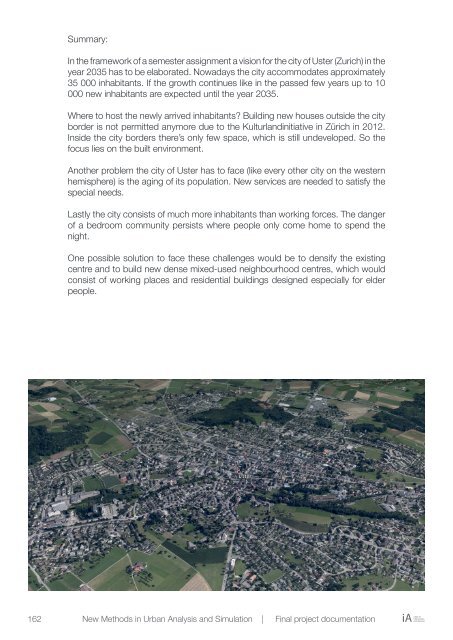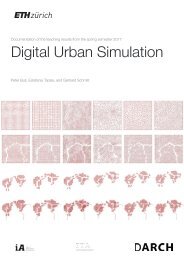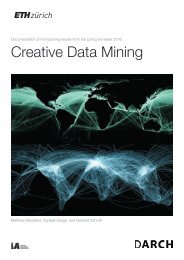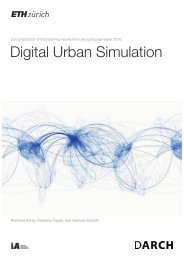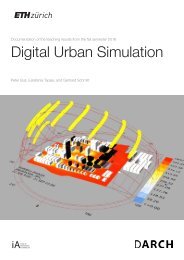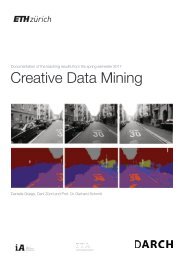Digital Urban Simulation : Documentation of the Teaching Results from the Autumn Semester 2015
Create successful ePaper yourself
Turn your PDF publications into a flip-book with our unique Google optimized e-Paper software.
Wit<br />
cho<br />
Ch<br />
Ac<br />
<strong>the</strong><br />
it p<br />
nea<br />
The<br />
sho<br />
The<br />
ing<br />
new<br />
Inte<br />
Page example 1<br />
Summary:<br />
In <strong>the</strong> framework <strong>of</strong> a semester assignment a vision for <strong>the</strong> city <strong>of</strong> Uster (Zurich) in <strong>the</strong><br />
year 2035 has to be elaborated. Nowadays <strong>the</strong> city accommodates approximately<br />
35 000 inhabitants. If <strong>the</strong> growth continues like in <strong>the</strong> passed few years up to 10<br />
000 new inhabitants are expected until <strong>the</strong> year 2035.<br />
Lebendiges Uster 2035<br />
Where to host <strong>the</strong> newly arrived inhabitants? Building new houses outside <strong>the</strong> city<br />
border is not permitted anymore due to <strong>the</strong> Kulturlandinitiative in Zürich in 2012.<br />
Inside <strong>the</strong> city borders <strong>the</strong>re’s only few space, which is still undeveloped. So <strong>the</strong><br />
focus lies on <strong>the</strong> built environment.<br />
Final Examination<br />
Name: Vincent Ano<strong>the</strong>r Hischier problem <strong>the</strong> city <strong>of</strong> Uster has to face (like every o<strong>the</strong>r city on <strong>the</strong> western<br />
Date: 30. hemisphere) November <strong>2015</strong> is <strong>the</strong> aging <strong>of</strong> its population. New services are needed to satisfy <strong>the</strong><br />
special needs.<br />
Summary: Lastly <strong>the</strong> city consists <strong>of</strong> much more inhabitants than working forces. The danger<br />
<strong>of</strong> a bedroom community persists where people only come home to spend <strong>the</strong><br />
In <strong>the</strong> framework night. <strong>of</strong> a semester assignment a vision for <strong>the</strong> city <strong>of</strong> Uster (Zurich) in <strong>the</strong> year 2035 has to be<br />
elaborated. Nowadays <strong>the</strong> city accommodates approximately 35 000 inhabitants. If <strong>the</strong> growth continues like<br />
in <strong>the</strong> passed<br />
One<br />
few<br />
possible<br />
years up<br />
solution<br />
to 10 000<br />
to<br />
new<br />
face<br />
inhabitants<br />
<strong>the</strong>se challenges<br />
are expected<br />
would<br />
until<br />
be<br />
<strong>the</strong><br />
to<br />
year<br />
densify<br />
2035.<br />
<strong>the</strong> existing<br />
Where to host <strong>the</strong> newly arrived inhabitants? Building new houses outside <strong>the</strong> city border is not permitted<br />
centre and to build new dense mixed-used neighbourhood centres, which would<br />
anymore due to <strong>the</strong> Kulturlandinitiative in Zürich in 2012. Inside <strong>the</strong> city borders <strong>the</strong>re’s only few space, which<br />
consist <strong>of</strong> working places and residential buildings designed especially for elder<br />
is still undeveloped. So <strong>the</strong> focus lies on <strong>the</strong> built environment.<br />
people.<br />
Ano<strong>the</strong>r problem <strong>the</strong> city <strong>of</strong> Uster has to face (like every o<strong>the</strong>r city on <strong>the</strong> western hemisphere) is <strong>the</strong> aging <strong>of</strong><br />
its population. New services are needed to satisfy <strong>the</strong> special needs.<br />
Lastly <strong>the</strong> city consists <strong>of</strong> much more inhabitants than working forces. The danger <strong>of</strong> a bedroom community<br />
persists where people only come home to spend <strong>the</strong> night.<br />
One possible solution to face <strong>the</strong>se challenges would be to densify <strong>the</strong> existing center and to build new<br />
dense mixed-used neighborhood centers, which would consist <strong>of</strong> working places and residential buildings<br />
designed especially for elder people.<br />
Mo<br />
As<br />
Wh<br />
net<br />
loc<br />
Las<br />
An<br />
and<br />
<strong>the</strong><br />
cou<br />
An<br />
162<br />
New Methods in <strong>Urban</strong> Analysis and <strong>Simulation</strong> | Final project documentation<br />
Chair <strong>of</strong><br />
Information<br />
iA Architecture<br />
The<br />
bes<br />
cho


